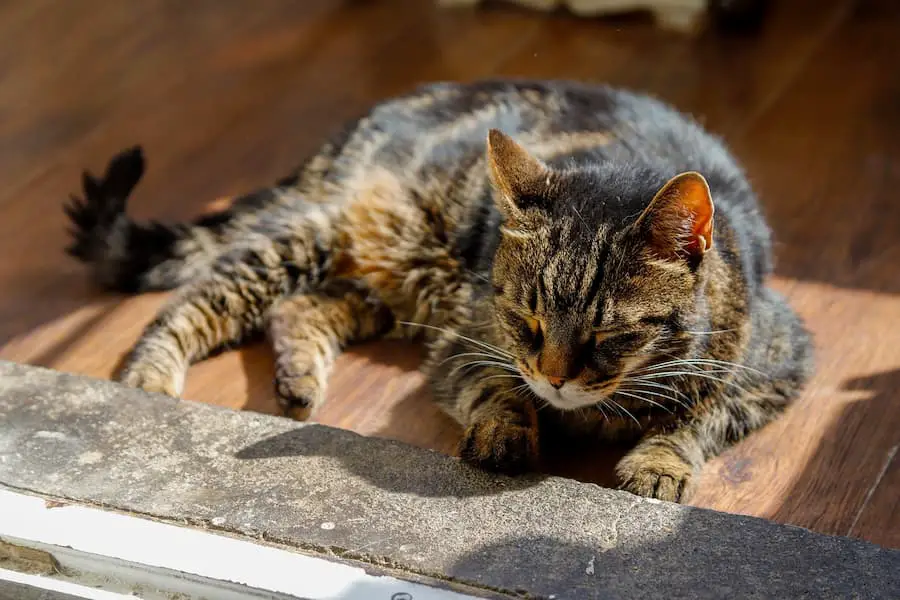Why Your Old Cat Are Getting Their Claws Stuck
If you own an older cat, you’ve maybe started to notice little changes happening as part of the cat’s ageing process. Although most people know that hearing and vision get worse as cats age, older cats also have claw issues as they get older.
Potential Claw Problems
With older cats, claw thickness is one of the main reasons a cat gets their claws stuck. As an older cat’s claws grow significantly thicker than younger cats, the claws can also become especially dry and weak in texture. Older claws are significantly easier to break and also have a tendency to become overgrown. Another problem for older cats is nail retraction which becomes more and more difficult as the cat ages. As these issues are problematic, it’s vital to pay close attention to the claws of an older cat that’s around 10 years old or older.
Trimming
If you have been using a designated scratching post for your cat, they mightn’t be as interested in using it as they’ve gotten older, their claws weaken. This means that your cat’s claw maintenance depends more and more on you. To prevent overgrowing nails, try to clip and file down their claws on a regular basis. Not only will this keep their claws sturdier and stronger, but it will also make it easier for you to identify any potential paw wounds or injuries your older cat may experience.
Osteoarthritis
Osteoarthritis can be a relatively common health ailment for older cats. Along with joint aches, decreased activity and mobility difficulties, overgrown claws are often a telltale sign of the condition. If overgrowth is a big problem for your cat, it’s possible that they may have osteoarthritis–in that case, you should schedule a veterinarian appointment to get your cat checked as soon as possible.
Claw Neglect
If you allow your older cat’s claw situation to get out of hand, it could deeply affect their health. If their claws are overgrown, the cat could experience pain and difficulty walking. Apart from jeopardizing your precious cat’s health, the neglect of claw trimming could mean that your furnishings get the brunt of it.
If you’ve tried the desensitization approach but your cat still won’t let you trim their nails, there are several options you can try. You can try wrapping your cat in a towel, exposing one leg at a time. It’s best to have someone to help you, so while one of you restrains the cat, the other can trim the nails. Just make sure that your helper knows how to gently and safely restrain a cat. As a resort, you can take your cat to a veterinary clinic to get their nails trimmed.
For most cat owners, one of the most dreaded cat grooming experiences is likely trimming their cat’s nails. Trimming nails can feel like a battle with cats, and may even try to claw or bite. However, just because your senior cat makes the grooming process difficult doesn’t mean that you can avoid it.
Why Is Feline Nail Trimming So Important?
As your cat’s nails grow in layers, accumulating overtime. These layers need to be shed every so often to prevent the nails from becoming ingrown and painful. This problem isn’t as much a problem for younger cats as they’re able to keep their own nails in check by using scratching posts.
As cats age, nail trimming becomes even more important. An older cat with arthritis may have a decreased ability to take care of their own nails without pain. Elderly cats can have more problems scratching at posts to sharpen them and keep them in good shape on their own. Older cats tend to have thicker and brittle nails that will need to be trimmed more often to avoid overgrowth.
Not trimming nails and letting the layers add up can lead to overgrown nails, which will curve towards a cat’s paw pad. If the nail grows too long, it could puncture the paw pad, leading to painful wounds.
As elderly cats aren’t always able to retract their claws as easily as young cats, this can put them at a greater risk of getting them stuck on the carpet or furniture, resulting in broken nails.
Tips To Trim Your Older Cat’s Nails Successfully
To be safe, you’ll want to try and trim your elderly cat’s nails around every two weeks. Always use special animal nail clippers, as the correct clippers will help to minimize accidental harm to your cat’s nails.
Of course, getting your cat used to nail trimming is easiest when you start at a young age. However, if you have an older cat, trimming their nails may be a little more difficult if they’re not used to it, but it’s not impossible—you’ll just need more patience.
To make things go as smoothly as possible, you’ll want to make sure your cat is calm or even sleepy. A more relaxed cat is far less likely to put up a fight. You could massage your cat’s paws gently, giving the cat time to adjust to being touched on the paws and taking breaks if they get agitated. You mightn’t be able to trim their nails the first few times you try this, but with time, it should get easier.
Try getting your cat used to the sound of your nail clippers. Hold your cat and press the clippers together a few times to allow your cat to understand the sound and where it’s coming from. When your cat gets more comfortable, press its paw so the nail extends, then gently trim one nail at a time in one quick motion. You’ll want to trim it, creating a blunt edge and removing the sharp tip. When trimming, always be careful to avoid hitting the quick. The quick is the part of the nail where it turns red.
Make sure to give your cat a treat as a reward after their nails are trimmed to encourage future cooperation. However, if your cat won’t allow you to touch their nails, then you should consider asking a vet or groomer for assistance. You shouldn’t let nail trimming fall to the wayside, as it’s very important to prevent your senior cat from getting their claws stuck.









